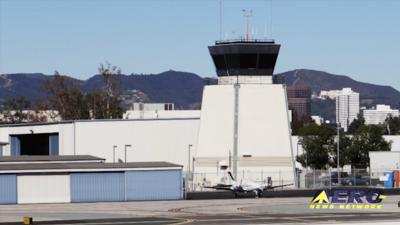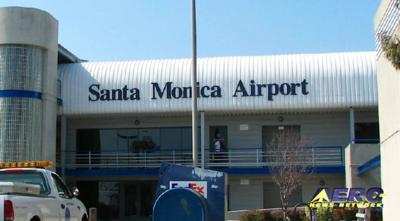1923-2028, Beloved Mother of Noise Abatement Protocols
In 2022, the Santa Monica Airport (SMO) celebrated its 99th anniversary. Among the United States' oldest and foremost general aviation facilities, SMO, at one time, was the world’s busiest single-runway airport.

Founded in 1923 as Clover Field, the Santa Monica Airport covers a total of 227-prime acres within two-miles of Southern California’s Pacific coast and six-miles of Los Angeles International Airport (LAX). The FAA’s National Plan of Integrated Airport Systems categorizes SMO as a reliever airport.
SMO’s historical significance is estimable. In addition to being the original home of the storied Douglas Aircraft company, the airport served as both departure and arrival point for the world’s first arial global circumnavigation—a 175-day, 26,345-mile odyssey flown in 1924 by aviators of the United States Army Air Service—a precursor of today’s United States Air Force.
Historical and infrastructural import notwithstanding, the Santa Monica City Council has resolved to close SMO by 2028—approving a closure plan and timeline during a 24 January 2023 meeting.
Santa Monica Mayor Gleam Davis set forth in a press release: “This is the beginning of a community process to reimagine the Airport site, which accounts for an unprecedented 4.3-percent of the city’s land. We know this is an asset Santa Monicans care about and we want to work together to set goals and priorities to meet diverse community needs for the next several generations.”
For over fifty-years, the city of Santa Monica has existed in a state of near-perpetual litigation with the Federal Aviation Administration (FAA) over control of SMO airport operations and the use of the land upon which the facility currently stands. Since the 1970s, the city has sought relentlessly to wrest control of the airport from the FAA by means of local ordinances haphazardly contrived and hurriedly passed at the behest of monied citizens antipathetic to aircraft operations.
Throughout the decades spanning Arthur Fonzarelli’s rise and Disney Corp’s fall, numerous campaigns seeking to affect SMO’s closure have been undertaken by groups at once well-heeled and short-sighted. Two such groups—Citizens Against Santa Monica Airport Traffic (CASMAT) and Sunset Park Anti-Airport, Inc., (SPAA)—contended vehemently that the airport required immediate and prejudicial closure on account of: its proximity to residential neighborhoods; the potential for airplane crashes; and new homeowners in the area immediately surrounding SMO not caring for the airport.
Stooping to the basest civil legerdemain, CASMAT and SPAA purported the existence of poll, eighty-percent of the ostensible respondents to which allegedly favored SMO’s closure.
In 2013, unable to actualize their ultimate aim, the two groups petitioned the City of Santa Monica to close two-thousand-feet of the airport’s runway. That such a measure would imperil aircraft, air travelers, and persons and property in the vicinity of SMO’s arrival and departure paths was a feat of cognition beyond the collective purview of the groups’ leaders.

A “consent decree” agreed upon in 2017 by the FAA and the City of Santa Monica calls for the former to return the airport land and its usage to the latter on 31 December 2028, thereby empowering the city to close SMO.
A document from the office of Santa Monica’s City Clerk summarized the agreement thus: “After years of trying to assert local control over Airport activities and use of the Airport property, the City entered into a Settlement Agreement and ‘Consent Decree’ with the United States of America and the Federal Aviation Administration that resolved all outstanding disputes between the parties and relinquished all claims by the U.S. and the FAA as to Airport land.”
Pursuant its plans for the airport’s closure, the City of Santa Monica intends to “invite community participation in designing what may be the greatest transformative event of this century for the City of Santa Monica, and perhaps the region.”
A measure passed in 2014 affords the Santa Monica City Council discretion over the use of the 227 acres the city is slated to reacquire following SMO’s closure. The measure further empowers the City Council to approve the development of parks, public open spaces and recreational facilities, as well as the maintenance and replacement of extant cultural, arts, and educational installations on the land. The development of new real estate ventures on the property is prohibited, excepting limited undertakings approved by the voters.
During the 24 January meeting, the City Council “confirmed the values establish a standard for the Airport conversion process, foundational goals of sustainability and resiliency for the future of the Airport, and goals for an inclusive community space centered around the concept of a Great Park and supporting land uses.”
The process by which the Santa Monica City Council intends to move forward will commence with an early 2023 Request For Qualifications (RFQ) by which the legislative body will seek to identify qualified firms or multi-disciplinary teams capable of helping the city and community jointly address the possibilities and challenges occasioned by SMO’s closure. The City Council asserts subject course of action “will allow staff to evaluate the merits of each firm or team against an established criterion, before requesting detailed proposals. A shortlist of qualified firms or teams will be established through this evaluation and shortlisted candidates will later be invited to submit detailed process and cost proposals for the project.”

Following comprehensive RFQ evaluation, the Santa Monica City Council will issue a Request for Proposal (RFP) seeking “input from the community so that residents and other stakeholders have the opportunity to articulate their interests in how the planning process is shaped from inception.”
For purpose of ensuring the RFP instantiates a “detailed expression of community interest, concerns, and other factors that are important to Santa Monicans,” Santa Monica City staff will meet with municipal boards and commissions, neighborhood groups, the Chamber of Commerce, Santa Monica Travel and Tourism, and business-related interests such as merchants’ associations and local business improvement districts. Thereafter, presumably provisioned with a multitude of disparate, wholly irreconcilable opinions pertaining to the use of the former SMO lands, the Santa Monica City Council—after the immutable fashion of elected bureaucrats—will all but certainly vote in accordance with the avaricious aims of its members and their backers.
To the subject of SMO’s closure, the City of Santa Monica’s press release cites the following timeline:
- Consultant Selection: Summer 2023
- Project Initiation: Winter 2023
- Existing Conditions: Spring 2024
- Scenario Planning (Preferred Scenario Approved): Spring/Summer 2026
- Specific Plan Initiation: Fall/Winter 2026
- Consent Decree Airport Closure Authorization: Winter 2028
- Specific Plan Adoption: Fall 2028-2033 or beyond
E-I-C Note: In what was probably the biggest mistake made by the FAA in regards to GA matters, the SMO debacle stands out as a massive bit of bad decision-making... and so was the relative inaction of the alphabet associations in rolling over and not fighting this with EVERY weapon at their disposal. We will come to see this as an extremely dangerous precedent. -- Jim Campbll, ANN E-I-C, CEO
 ANN's Daily Aero-Term (12.01.25): Convective SIGMET
ANN's Daily Aero-Term (12.01.25): Convective SIGMET ANN's Daily Aero-Linx (12.01.25)
ANN's Daily Aero-Linx (12.01.25) NTSB Final Report: Remos Aircraft GmbH Remos GX
NTSB Final Report: Remos Aircraft GmbH Remos GX Aero-News: Quote of the Day (12.02.25)
Aero-News: Quote of the Day (12.02.25) ANN's Daily Aero-Term (12.02.25): Coupled Approach
ANN's Daily Aero-Term (12.02.25): Coupled Approach





